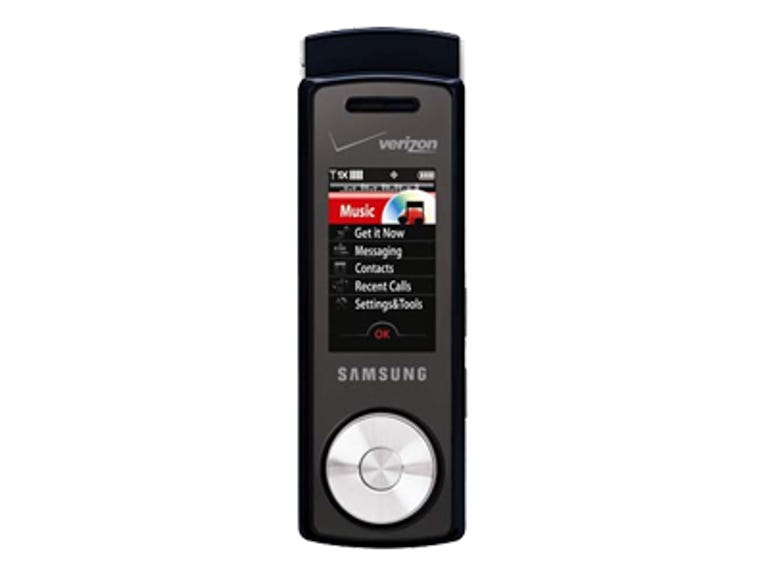The Good
The Bad
The Bottom Line
When we first saw the Samsung Juke SCH-U740, we weren't sure if it was a cell phone or an MP3 player. Its shape is reminiscent of the lipstick design of the Nokia 7380, but unlike the 7380, the Juke has a swivel hinge that swings the phone open to reveal a keypad. This unique design certainly gives the Juke some serious sex appeal, but that's about where it stops. Feature-wise, the Juke is a bit of a dud. There's no video-recording capability, and most disappointing of all is the lack of V Cast access. For a music-focused phone like this, we would've really liked to have V Cast Music access so we could download music on the fly. But the disappointment doesn't stop there; the lack of an expandable memory slot and a few design annoyances make the Juke a lot less sexy than we thought it was at first. The Samsung Juke is available from Verizon Wireless for $99.99 with a two-year contract.
Design
At first glance, the Juke does indeed look like a distant cousin of the Nokia 7380, one of Nokia's lipstick-shaped phones. It almost has the same dimensions at 3.82 inches by 1.18 inches by 0.83 inch, which makes it resemble a large pack of chewing gum. Since it's so small, it's also quite lightweight, at 2.82 ounces. On closer inspection, however, the Juke looks quite different. It has a spun-metal scroll wheel similar to the LG Chocolate VX8550, and above the scroll wheel is a skinny, 1.45-inch display. The display supports 262,000 colors, which is great, but since the screen is so small, it didn't make a big impact. Images still looked great though. You can adjust the screen's backlight time and brightness, plus the style and size of the dial fonts. When holding the Juke closed with the scroll wheel on the bottom, the hold switch, the charger, and the headset jack are on the left spine, while the volume rocker is on the right.


Features
While the Samsung Juke may have wowed us with its design, it certainly failed to do that with its features. But before we go into why we're so disappointed, let's start with the basics. The Samsung Juke comes with a 500-entry phone book with room in each entry for five numbers, two e-mail addresses, and notes. Contacts can also be paired with a group, a picture for caller ID, or 1 of 11 polyphonic ringtones. Other basic features include a vibrate mode, a speakerphone, text and multimedia messaging, voice commands, a calculator, a calendar, an alarm clock, a stopwatch, a world clock, and a notepad. There's also instant messaging and stereo Bluetooth support.
We feel that the most important thing lacking from this feature set is the lack of 3G support, plus the lack of mobile Web access. This means that the Juke does not have access to V Cast Music, which is arguably one of Verizon's biggest strengths in the mobile music space. The inability to download music over the air makes the Juke look almost crippled when compared to other music phones in Verizon's stable, like the LG Chocolate or the LG VX8350. Sure, the phone may have a good music player (as we'll go into in the next paragraph), but the lack of V Cast Music in a supposedly music-focused phone from Verizon is a pretty big misstep.
As the name implies, the Samsung Juke has a built-in music player. It's only accessible when the phone is closed, and you can use the scroll wheel to navigate through the playlist and music options. The interface is pretty generic, though you do have a choice of music player skins, such as a visualizer or album artwork. The Juke also has a choice of preset equalizer and 3D sound settings. As mentioned, the only way to sync up music to the Juke is via PC syncing, and you can do this with either Windows Media Player or Verizon's own Music Manager software. The music player supports MP3, WMA, WMA Pro, AAC, and AAC+ file formats. The Juke doesn't have an expandable memory slot, so you're stuck with the 2GB of internal storage.


Performance
We tested the dual-band (CDMA 800/1900; 1X/RTT digital only) Samsung Juke in San Francisco using Verizon Wireless service. We were quite impressed with the call quality, with good sound clarity and decent volume. Callers reported similar results, though with the speakerphone mode, they thought we sounded a little muffled. We were able to pair the Samsung Juke with the Cardo S-2 stereo Bluetooth headset without a problem, and managed to use it for both calls and music without any problems.
Music quality was actually pretty good for such a small device. The sound quality was rather thin when heard on the speakerphone, but with a headset on, it sounded fine. The Samsung Juke has a rated talk time of 3.5 hours and a rated standby time of 10 days. We managed to get a talk time of 4 hours, 10 minutes in our tests. According to FCC radiation tests, the Samsung Juke has a digital SAR rating of 1.04 watts per kilogram.



